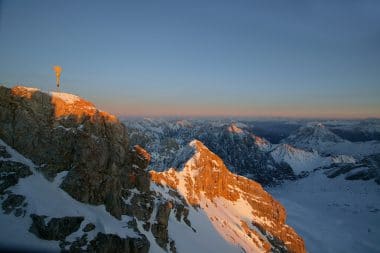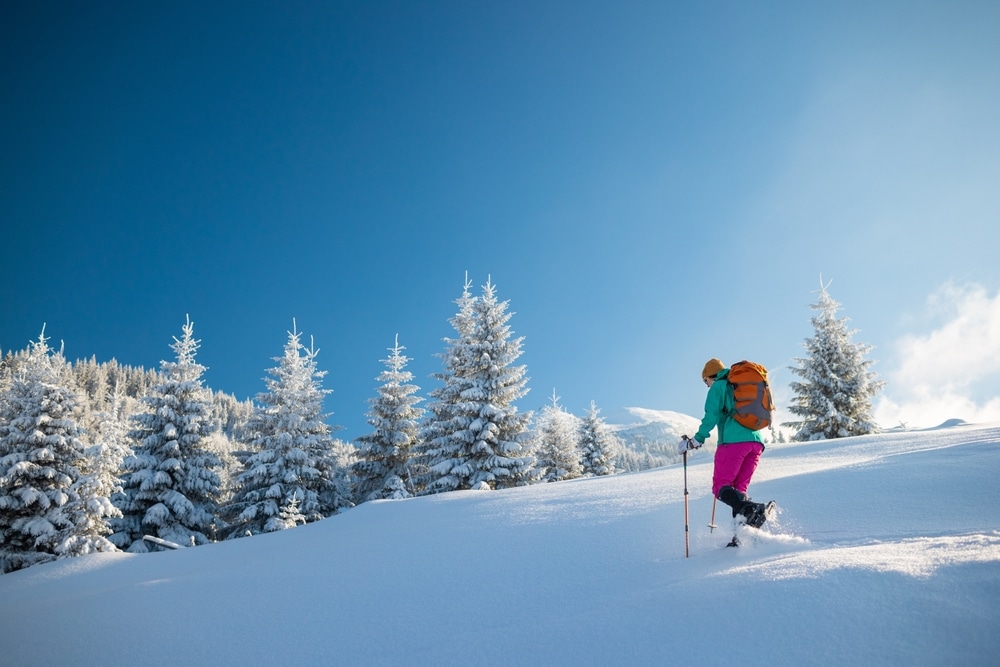Snowshoeing is becoming increasingly popular with nature lovers who are looking for a quiet and intensive way of winter hiking away from the overcrowded ski resorts. In this article, you’ll learn everything you need to know about snowshoeing – from popular destinations to the right equipment and tips for beginners. Immerse yourself in the fascinating world of snowshoeing!
1. What is snowshoeing and why is it so popular?
Snowshoeing is a form of winter hiking in which you move over snow-covered landscapes on special snowshoes. Originally used as a means of transport for hunters and trappers, snowshoeing has become a popular winter sport in recent decades. The great advantage of snowshoeing is that you can move freely in deep snow without sinking deep. It is a wonderful way to immerse yourself in snowy nature, far away from crowded slopes and hectic ski tourism.
2. Popular destinations for snowshoeing

For snowshoeing, there are a variety of great places that are characterized by untouched nature, breathtaking views and ideal snow conditions. Here are some of the most popular destinations:
- Bavarian Alps, Germany: In the region around Garmisch-Partenkirchen and Berchtesgaden there are numerous, well-signposted snowshoe hiking trails that offer spectacular views and varied tours.
- Dolomites, Italy: The Dolomites are known for their striking rock formations and offer a variety of trails that are suitable for snowshoe hikers of all skill levels. The region around Cortina d’Ampezzo is particularly recommended.
- Pre-Alps, Switzerland: With countless, perfectly groomed routes, Switzerland is a paradise for snowshoe hikers. The canton of Graubünden or the Bernese Oberland offer an ideal mix of challenging tours and relaxed routes.
- Norway: Norway’s wintry landscape is perfect for snowshoeing. Especially in the Rondane and Jotunheimen national parks, you can enjoy the real Nordland feeling and enjoy endless expanses.
- Rocky Mountains, USA: In the Rocky Mountains, you can look forward to fascinating routes and snowy landscapes, for example in the states of Colorado and Montana.
3. The right equipment for snowshoeing
Snowshoeing requires special equipment, but it is kept within a manageable range compared to other winter sports. Here is an overview of the most important pieces of equipment:
- Snowshoes: The choice of snowshoes is crucial. There are snowshoes for different types of terrain and levels of difficulty. Lightweight models are suitable for easy terrain and packed snow, while larger snowshoes are ideal for deep powder.
- Sticks: Hiking poles with snow plates provide stability and make the ascent easier. They are especially helpful on slippery or steep passages and protect the joints.
- Winter sports clothing: In winter conditions, the right clothing is essential. Multi-layered, breathable clothing keeps you warm and at the same time ensures a good body climate. Gloves, a hat and warm socks are also part of the basic equipment.
- Avalanche equipment: In areas with avalanche danger, it is important to carry an avalanche shovel, an avalanche transceiver and a probe. Basic knowledge of how to use this equipment is also important.
4. Tips for beginners: How to get started with snowshoeing
Snowshoeing is relatively easy to learn for beginners, but a few basic skills and tips will make it easier to get started:
- Proper planning: Before each tour, you should find out about the weather conditions, snow conditions and possible avalanche danger. It is also helpful to stick to designated snowshoe routes.
- Learning to walk: Walking on snowshoes requires some practice, as the steps must be slightly wider than normal walking. It’s best to start on flat routes to get a feel for getting around.
- Plan breaks: Since snowshoeing on deep snow is physically demanding, regular breaks are important. Take enough water and snacks with you to have enough energy and fluids.
- Groups or guided tours: Guided snowshoe tours are ideal for beginners. Experienced guides know the routes, point out danger spots and give valuable tips.
5. Environmentally friendly and sustainable on the road in the snow
Environmental protection plays a major role in snowshoeing. The quiet locomotion protects nature and allows you to experience the wintry landscape without noise or exhaust fumes. Nevertheless, there are some principles for environmentally friendly behavior:
- Stay on marked trails: In order not to damage the vegetation under the snow, it is advisable to stay on marked trails.
- Do not disturb animals: Many wild animals are in energy-saving mode in winter. Be careful not to be quiet and not to scare the animals so as not to stress them unnecessarily.
- Take garbage with you: Of course, any garbage should be taken back with you. Natural paradises like these will only be preserved if all visitors make their contribution.
Snowshoeing offers the perfect mix of sporting activity and nature experience. With the right equipment and good preparation, you can enjoy the winter wonderland in all its glory.


